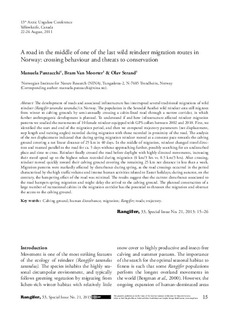A road in the middle of one of the last wild reindeer migration routes in Norway: crossing behaviour and threats to conservation
Peer reviewed, Journal article
Published version
Permanent lenke
http://hdl.handle.net/11250/2480558Utgivelsesdato
2013Metadata
Vis full innførselSamlinger
- Publikasjoner fra CRIStin - NINA [2364]
- Scientific publications [1392]
Originalversjon
Rangifer. 2013, 33 (Special Issue No 21), 15-26.Sammendrag
The development of roads and associated infrastructure has interrupted several traditional migrations of wild reindeer (Rangifer tarandus tarandus) in Norway. The population in the Setesdal Austhei wild reindeer area still migrates from winter to calving grounds by semi-annually crossing a cabin-lined road through a narrow corridor, in which further anthropogenic development is planned. To understand if and how infrastructure affected reindeer migration patterns we studied the movements of 10 female reindeer equipped with GPS collars between 2002 and 2010. First, we identified the start and end of the migration period, and then we compared trajectory parameters (net displacement, step length and turning angles) recorded during migration with those recorded in proximity of the road. The analysis of the net displacement indicated that during spring migration reindeer moved at a constant pace towards the calving ground covering a net linear distance of 25 km in 40 days. In the middle of migration, reindeer changed travel direction and roamed parallel to the road for ca. 5 days without approaching further, possibly searching for an undisturbed place and time to cross. Reindeer finally crossed the road before daylight with highly directed movements, increasing their travel speed up to the highest values recorded during migration (4 km/3 hrs vs. 0.5 km/3 hrs). After crossing, reindeer moved quickly toward their calving ground covering the remaining 25 km net distance in less than a week. Migration patterns were markedly affected by disturbance during spring, as the road crossings occurred in the period characterized by the high traffic volume and intense human activities related to Easter holidays; during autumn, on the contrary, the hampering effect of the road was minimal. The results suggest that the current disturbance associated to the road hampers spring migration and might delay the arrival to the calving ground. The planned construction of a large number of recreational cabins in the migration corridor has the potential to threaten the migration and obstruct the access to the calving ground. Calving ground, human disturbance, migrattion, Rangifer, roads, trajectory
